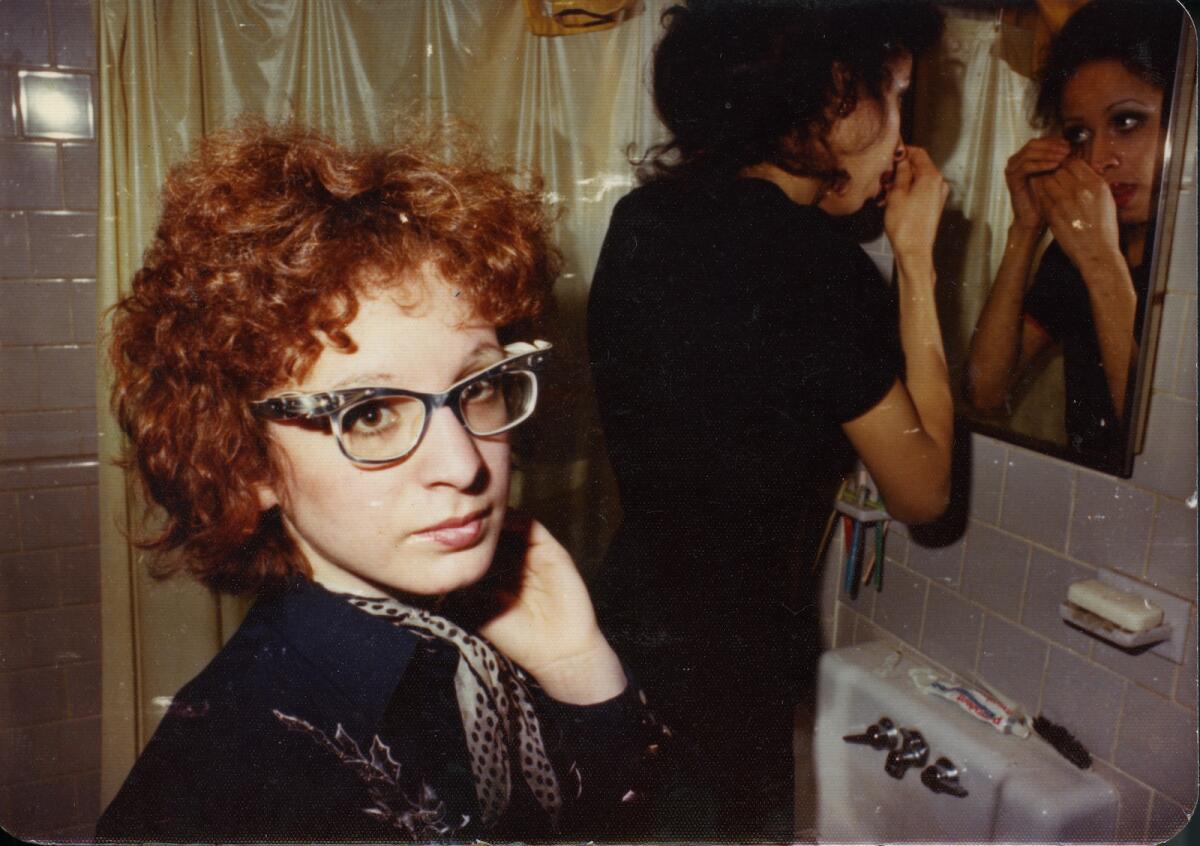The art, rage and action of Nan Goldin in ‘All the Beauty and the Bloodshed’

- Share via
Where life wounds, art and fellowship can heal, or at the very least, cauterize into the most expressive of scars. Photographer Nan Goldin knows this as much as anyone, her life’s journey from suburban captivity to outsider freedom, from Polaroid chronicler of her circle of intimates to consequential artist/activist, is all on moving, enriching display in Oscar-winning filmmaker Laura Poitras’ enthralling documentary, “All the Beauty and the Bloodshed.”
If you’ve ever doubted how art, rage or action can make meaningful change, Goldin’s combination of all three fighting an opioid crisis that nearly killed her is exhilarating proof of the power of “screaming in the streets,” to borrow what the queer artist David Wojnarowicz — one of many close friends of Goldin’s whom the AIDS epidemic took — wryly described as a necessary ritual of the living in a time of too much death.
For your safety
The Times is committed to reviewing theatrical film releases during the COVID-19 pandemic. Because moviegoing carries risks during this time, we remind readers to follow health and safety guidelines as outlined by the CDC and local health officials.
When Goldin, in recovery from her own scary OxyContin addiction, learned that the wealthy Sackler family, owners of the drug’s maker, Purdue Pharma, were all over her world as art benefactors, she created PAIN (Prescription Addiction Intervention Now) as an ACTUP-inspired group aimed at advocating for more treatment funding from opioid profits, and shaming museums bearing the Sackler name into refusing the family’s reputation-washing money.
Starting in 2018, she spearheaded “die-ins” inside the Met and the Guggenheim, with flung pill bottles, coruscating banners (“400,000 DEAD”), shouts (“Sacklers lie, people die!”), and arrayed bodies signifying the drug’s deathly toll. The footage of these actions — the verité center of Poitras’ biographical portrait of Goldin — have a fierce glory, planned eruptions in elite spaces that, as we learn from the story threaded artfully throughout the documentary, speak to how important truth, community and unfettered expression have been across Goldin’s life.
Her spare, vivid, candid voice-over guides us through her birth as an artist, which begins in a home racked by secrets and tragedy surrounding the suicide of her older sister Barbara, a figure whose rebellious streak in a stifling middle-class existence become a guiding force for the younger, shyer Goldin as she navigated adulthood. Finding a new family among the gender-nonconforming and creative, she turned her treasured relationships in a marginalized community into the stuff of deeply personal snaps that in the art world counted as a subversive, soulful and destigmatizing photographic truth.
Goldin’s descriptions of Bowery scrappiness, nocturnal multi-tasking, and underground socializing bring that street-romantic bohemia alive, as do remembrances of friends such as actress/writer Cookie Mueller (where’s her documentary?), the political awakening from her time bartending for Tin Pan Alley owner Maggie Smith, and in the late ‘80s curating the controversial multidisciplinary AIDS-themed gallery show “Witnesses.”
Laura Poitras’ documentary tracks artist Nan Goldin through her activism against billionaire museum donors.
Poitras, whose gift for suspenseful contemplation is on full display here, layers her subject’s frank memories and insights over a rolling bounty of her photographs — the style evokes Goldin’s legendary slideshows, the most famous of which is “The Ballad of Sexual Dependency” (which is excerpted). We even hear a shutter click occasionally too, a sonic touch that gently reinforces the intimacy of our watching and listening, while the sparsely deployed Soundwalk Collective score and other music cues feel like an ethereal bridge between Goldin’s past epiphanies and present crusade.
That interweaving of the woman she was and is eventually arrives at a beautiful, hard-won catharsis when PAIN’s efforts get desired results from the art world, and it feels as though we’re seeing the personal, the professional, and the political in Goldin’s life achieve a radical harmony.
Late in “All the Beauty and the Bloodshed” — a title whose origin, when revealed, carries unbearable poignancy — there’s a scene in which Goldin takes part in a Zoom hearing that requires the Sacklers, looking for a settlement, to hear and view in real time the testimony of OxyContin addiction victims. When Goldin’s turn comes, the camera captures a PAIN colleague supportively gripping this dedicated artist/activist’s trembling hand. It feels like a moment she would want for her collection of cherished memories: a spontaneous image of pain, perseverance, righteous expression, and the tender gesture that says, “I’m with you.”
'All the Beauty and the Bloodshed'
Not rated
Running time: 1 hour, 57 minutes
Playing: Starts Dec. 2, AMC Sunset 5, West Hollywood
More to Read
Only good movies
Get the Indie Focus newsletter, Mark Olsen's weekly guide to the world of cinema.
You may occasionally receive promotional content from the Los Angeles Times.










